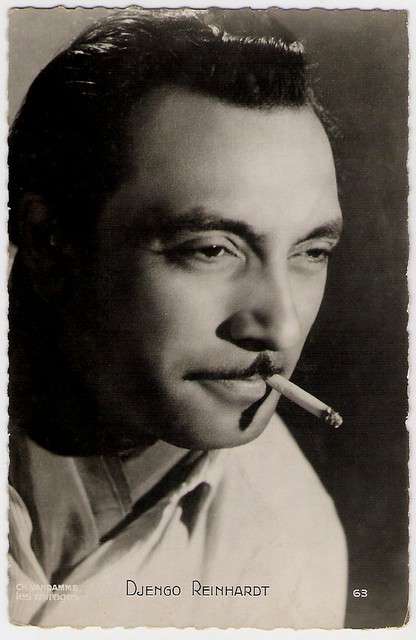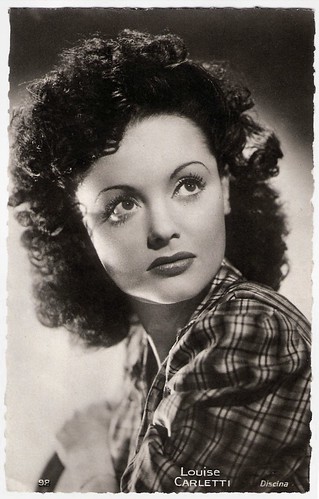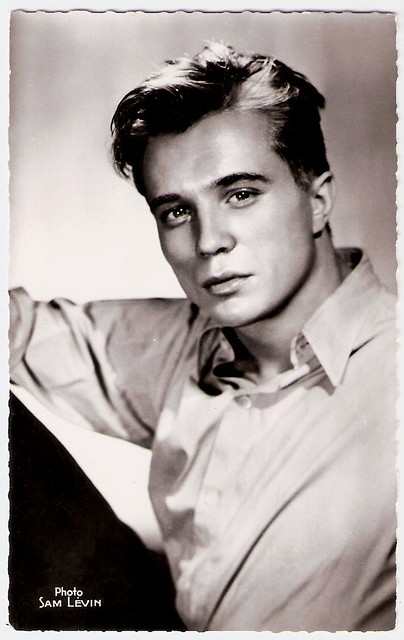Gypsy guitarist Django Reinhardt (1910-1953) was one of the first prominent European jazz musicians. His fret hand was severely burned and disfigured and caused his unique style of playing. He performed with such greats as Louis Armstrong, Count Basie and Duke Ellington. He also had his own band, the Quintette du Hot Club de France, which he had cofounded with violinist Stéphane Grappelli. Django has been portrayed in several films, even as a cartoon character, and his music graces the soundtracks of many films, especially those of Woody Allen.

French postcard by Editions P.I., Paris, no. 63. Photo: Ch. Vandamme / Les Mirages.
Jean Baptiste Reinhardt was born into a troupe of gypsies in Liberchies, Belgium, in 1910. He was the son of a travelling entertainer and the brother of guitarist Joseph Reinhardt. From the age of 8, he lived with his mother in Romani (Gypsy) settlements close to Paris.
Reinhardt's nickname ‘Django’ is Romani for ‘I awake.’ He started playing the violin and eventually moved on to a banjo-guitar that a neighbour had given him.
From the age of 12, he played professionally at Bal-musette halls in Paris. His first known recordings (in 1928) were of him playing the banjo with accordionist Jean Vaissade for the Ideal Company.
That year, the 18 year old Reinhardt was injured in a fire that ravaged the caravan he shared with Florine ‘Bella’ Mayer, his first wife. The caravan was filled with celluloid flowers his wife had made to sell at the market on the following day. At one o'clock in the morning Django returned from a performance at the club La Java. Upon hearing a mouse among the flowers, he bent down with a candle to look. The wick from the candle fell into the highly flammable celluloid flowers and the caravan was transformed into a raging inferno.
Somehow he and his wife made it across the blazing room to safety outside, but his right leg was paralyzed and the third and fourth fingers of his left hand were badly burned. A doctor intended to amputate his leg, but Reinhardt refused to have the surgery and was bedridden for eighteen months.
His brother Joseph bought Django a new guitar. With rehabilitation and practice he relearned his craft in a completely new way. He created a whole new fingering system built around the two fingers on his left hand that had full mobility.
His fourth and fifth digits of the left hand were permanently curled towards the palm due to the tendons shrinking from the heat of the fire. He could use them on the first two strings of the guitar for chords and octaves but complete extension of these fingers was impossible.
In 1931 the painter Emile Savitry let him hear the records of Louis Armstrong and Duke Ellington, and Django decided to look out for French jazz musicians.

Louise Carletti. French postcard by Editions E.C., Paris, no. 92. Photo: Discina.
In 1934, Django Reinhardt and Parisian violinist Stéphane Grappelli formed the Quintette du Hot Club de France with Reinhardt's brother Joseph and Roger Chaput on guitar, and Louis Vola on bass. The small Ultraphone company recorded their first sides Dinah, Tiger Rag, Oh Lady be Good, and I Saw Stars. These first records caused a sensation.
The group went on to record hundreds of sides and had a following on both sides of the ocean. The quintet was one of the few well-known jazz ensembles composed only of string instruments. At the time, the great majority of recordings featured a wide variety of horns, often in multiples, piano, etc.
In the years before World War II the group gained considerable renown, and Reinhardt became an international celebrity. He appeared throughout Europe and recorded with many important American jazz musicians such as Coleman Hawkins, Benny Carter, and did a jam-session and radio performance with Louis Armstrong.
Reinhardt could neither read nor write music, and was barely literate, but Stéphane took the band's downtime to teach him. When World War II broke out, the original quintet was on tour in the United Kingdom. Reinhardt returned to Paris at once, leaving his estranged wife Florine behind. In 1929, she had given birth to their son named Henri ‘Lousson’ Reinhardt. Grappelli remained in the United Kingdom for the duration of the war.
Reinhardt reformed the quintet, with Hubert Rostaing on clarinet replacing Grappelli's violin. In 1943, Django married Sophie Ziegler in Salbris, with whom he had a son, Babik Reinhardt, who became a respected guitarist in his own right.
Reinhardt survived the war unscathed, unlike the many Romanis who perished in the Porajmos, the Nazi regime's systematic murder of several hundred thousand European Romanis. He apparently enjoyed the protection of the Luftwaffe officer Dietrich Schulz-Köhn, nicknamed ‘Doktor Jazz’, who deeply admired his music.

Philippe Lemaire. French postcard by Editions du Globe, Paris, no. 140. Photo: Sam Lévin.
After the war, Django Reinhardt rejoined Stéphane Grappelli in the UK, and then, in the fall of 1946, he went on tour in the United States as a special guest soloist with Duke Ellington and His Orchestra, playing two nights at Carnegie Hall.
He also became interested in composition and, with Andre Hodeir, arranged the music for the film Le Village de la Colère/The Village of Wrath (Raoul André, 1947) with Louise Carletti.
After returning to France, Reinhardt spent the remainder of his days re-immersed in Romani life, having found it difficult to adjust to the modern world. He would sometimes show up for concerts without a guitar or amp, or wander off to the park or beach, and on a few occasions he refused even to get out of bed.
Reinhardt was known by his band, fans, and managers to be extremely unpredictable. He would often skip sold-out concerts to simply "walk to the beach" or "smell the dew". However, he did continue to compose and is still regarded as one of the most advanced jazz guitarists to ever play the instrument.
Although his experience in the US left him influenced greatly by American jazz, making him a different player from the man Grappelli had known, on this recording Reinhardt switched back to his old roots, once again playing the acoustic Selmer-Maccaferri.
In 1951, he retired to Samois-sur-Seine, near Fontainebleau, where he lived until his death. He continued to play in Paris jazz clubs and finally came to terms with the electric guitar. His final recordings made in the last few months of his life show him moving in a new musical direction and are perhaps the most profound he or any other jazz guitarist ever made.
He had assimilated the vocabulary of bebop and fused it with his own melodic genius. His last recording of Nuages from these sessions is his greatest and from the same session in Manoir de mes Reves’ he distills in a couple of minutes an unrivaled beauty and pathos.
In 1953, he was also seen in the cinemas in the film Saluti e baci/The Road to Happiness (Maurice Labro, Giorgio Simonelli, 1953) with Philippe Lemaire.
That year Django Reinhardt suddenly collapsed outside his house from a brain hemorrhage. It took a full day for a doctor to arrive and Reinhardt was declared dead on arrival at the hospital in Fontainebleau. He was only 43.
After his death, the documentary Django Reinhardt (Paul Paviot, 1957) was made which includes an introduction by Jean Cocteau and features music performed by Grappelli, Rostaing, and Joseph Reinhardt.
Since then Django has been portrayed in several films. His legacy dominates Sweet and Lowdown (Woody Allen, 1999). This spoof biopic focuses on fictional American guitarist Emmet Ray's (Sean Penn) obsession with Reinhardt.
Django returned as a cartoon in the opening sequence of the animation film Les Triplettes de Belleville/The Triplets of Belleville (Sylvain Chomet, 2003). The third and fourth fingers of the cartoon Reinhardt are considerably smaller than the fingers used to play the guitar.
Reinhardt's music has been used in the soundtrack of many films, including Lacombe Lucien (Louis Malle, 1974), Gattaca (Andrew Niccol, 1993), The Matrix (Andy Wachowski, Larry Wachowski, 1999) and The Aviator (Martin Scorsese, 2004).
Django Reinhardt's film debut was the comedy Clair de Lune/Moonlight (Henri Diamant-Berger, 1932) with Claude Dauphin. The music is Django's but he can also be seen playing the guitar. Source: Jerome Diamant (YouTube).
Film clip from the film Le Route de Bonheur (1945). Django plays Nuits de Saint Germain de Près on his guitar in a train. Source: Teddy Dupont (YouTube).
Sources: Joseph Dinkins (Red Hot Jazz), Kevin Whitehead (Jazz), Find A Grave, Wikipedia, and IMDb.

French postcard by Editions P.I., Paris, no. 63. Photo: Ch. Vandamme / Les Mirages.
I Awake
Jean Baptiste Reinhardt was born into a troupe of gypsies in Liberchies, Belgium, in 1910. He was the son of a travelling entertainer and the brother of guitarist Joseph Reinhardt. From the age of 8, he lived with his mother in Romani (Gypsy) settlements close to Paris.
Reinhardt's nickname ‘Django’ is Romani for ‘I awake.’ He started playing the violin and eventually moved on to a banjo-guitar that a neighbour had given him.
From the age of 12, he played professionally at Bal-musette halls in Paris. His first known recordings (in 1928) were of him playing the banjo with accordionist Jean Vaissade for the Ideal Company.
That year, the 18 year old Reinhardt was injured in a fire that ravaged the caravan he shared with Florine ‘Bella’ Mayer, his first wife. The caravan was filled with celluloid flowers his wife had made to sell at the market on the following day. At one o'clock in the morning Django returned from a performance at the club La Java. Upon hearing a mouse among the flowers, he bent down with a candle to look. The wick from the candle fell into the highly flammable celluloid flowers and the caravan was transformed into a raging inferno.
Somehow he and his wife made it across the blazing room to safety outside, but his right leg was paralyzed and the third and fourth fingers of his left hand were badly burned. A doctor intended to amputate his leg, but Reinhardt refused to have the surgery and was bedridden for eighteen months.
His brother Joseph bought Django a new guitar. With rehabilitation and practice he relearned his craft in a completely new way. He created a whole new fingering system built around the two fingers on his left hand that had full mobility.
His fourth and fifth digits of the left hand were permanently curled towards the palm due to the tendons shrinking from the heat of the fire. He could use them on the first two strings of the guitar for chords and octaves but complete extension of these fingers was impossible.
In 1931 the painter Emile Savitry let him hear the records of Louis Armstrong and Duke Ellington, and Django decided to look out for French jazz musicians.

Louise Carletti. French postcard by Editions E.C., Paris, no. 92. Photo: Discina.
Hot Club de France
In 1934, Django Reinhardt and Parisian violinist Stéphane Grappelli formed the Quintette du Hot Club de France with Reinhardt's brother Joseph and Roger Chaput on guitar, and Louis Vola on bass. The small Ultraphone company recorded their first sides Dinah, Tiger Rag, Oh Lady be Good, and I Saw Stars. These first records caused a sensation.
The group went on to record hundreds of sides and had a following on both sides of the ocean. The quintet was one of the few well-known jazz ensembles composed only of string instruments. At the time, the great majority of recordings featured a wide variety of horns, often in multiples, piano, etc.
In the years before World War II the group gained considerable renown, and Reinhardt became an international celebrity. He appeared throughout Europe and recorded with many important American jazz musicians such as Coleman Hawkins, Benny Carter, and did a jam-session and radio performance with Louis Armstrong.
Reinhardt could neither read nor write music, and was barely literate, but Stéphane took the band's downtime to teach him. When World War II broke out, the original quintet was on tour in the United Kingdom. Reinhardt returned to Paris at once, leaving his estranged wife Florine behind. In 1929, she had given birth to their son named Henri ‘Lousson’ Reinhardt. Grappelli remained in the United Kingdom for the duration of the war.
Reinhardt reformed the quintet, with Hubert Rostaing on clarinet replacing Grappelli's violin. In 1943, Django married Sophie Ziegler in Salbris, with whom he had a son, Babik Reinhardt, who became a respected guitarist in his own right.
Reinhardt survived the war unscathed, unlike the many Romanis who perished in the Porajmos, the Nazi regime's systematic murder of several hundred thousand European Romanis. He apparently enjoyed the protection of the Luftwaffe officer Dietrich Schulz-Köhn, nicknamed ‘Doktor Jazz’, who deeply admired his music.

Philippe Lemaire. French postcard by Editions du Globe, Paris, no. 140. Photo: Sam Lévin.
Unrivalled Beauty and Pathos
After the war, Django Reinhardt rejoined Stéphane Grappelli in the UK, and then, in the fall of 1946, he went on tour in the United States as a special guest soloist with Duke Ellington and His Orchestra, playing two nights at Carnegie Hall.
He also became interested in composition and, with Andre Hodeir, arranged the music for the film Le Village de la Colère/The Village of Wrath (Raoul André, 1947) with Louise Carletti.
After returning to France, Reinhardt spent the remainder of his days re-immersed in Romani life, having found it difficult to adjust to the modern world. He would sometimes show up for concerts without a guitar or amp, or wander off to the park or beach, and on a few occasions he refused even to get out of bed.
Reinhardt was known by his band, fans, and managers to be extremely unpredictable. He would often skip sold-out concerts to simply "walk to the beach" or "smell the dew". However, he did continue to compose and is still regarded as one of the most advanced jazz guitarists to ever play the instrument.
Although his experience in the US left him influenced greatly by American jazz, making him a different player from the man Grappelli had known, on this recording Reinhardt switched back to his old roots, once again playing the acoustic Selmer-Maccaferri.
In 1951, he retired to Samois-sur-Seine, near Fontainebleau, where he lived until his death. He continued to play in Paris jazz clubs and finally came to terms with the electric guitar. His final recordings made in the last few months of his life show him moving in a new musical direction and are perhaps the most profound he or any other jazz guitarist ever made.
He had assimilated the vocabulary of bebop and fused it with his own melodic genius. His last recording of Nuages from these sessions is his greatest and from the same session in Manoir de mes Reves’ he distills in a couple of minutes an unrivaled beauty and pathos.
In 1953, he was also seen in the cinemas in the film Saluti e baci/The Road to Happiness (Maurice Labro, Giorgio Simonelli, 1953) with Philippe Lemaire.
That year Django Reinhardt suddenly collapsed outside his house from a brain hemorrhage. It took a full day for a doctor to arrive and Reinhardt was declared dead on arrival at the hospital in Fontainebleau. He was only 43.
After his death, the documentary Django Reinhardt (Paul Paviot, 1957) was made which includes an introduction by Jean Cocteau and features music performed by Grappelli, Rostaing, and Joseph Reinhardt.
Since then Django has been portrayed in several films. His legacy dominates Sweet and Lowdown (Woody Allen, 1999). This spoof biopic focuses on fictional American guitarist Emmet Ray's (Sean Penn) obsession with Reinhardt.
Django returned as a cartoon in the opening sequence of the animation film Les Triplettes de Belleville/The Triplets of Belleville (Sylvain Chomet, 2003). The third and fourth fingers of the cartoon Reinhardt are considerably smaller than the fingers used to play the guitar.
Reinhardt's music has been used in the soundtrack of many films, including Lacombe Lucien (Louis Malle, 1974), Gattaca (Andrew Niccol, 1993), The Matrix (Andy Wachowski, Larry Wachowski, 1999) and The Aviator (Martin Scorsese, 2004).
Django Reinhardt's film debut was the comedy Clair de Lune/Moonlight (Henri Diamant-Berger, 1932) with Claude Dauphin. The music is Django's but he can also be seen playing the guitar. Source: Jerome Diamant (YouTube).
Film clip from the film Le Route de Bonheur (1945). Django plays Nuits de Saint Germain de Près on his guitar in a train. Source: Teddy Dupont (YouTube).
Sources: Joseph Dinkins (Red Hot Jazz), Kevin Whitehead (Jazz), Find A Grave, Wikipedia, and IMDb.
2 comments:
Thank you. Although Django was not a real film star, we loved the card and to include his story in the blog.
I remember my father playing Reinhardt's records ages ago, but I had no idea his music was in so many films.
Great blog though! You got yourself another follower.
Please take a look at my own movie blog at:
www.cultcinema.net
Post a Comment